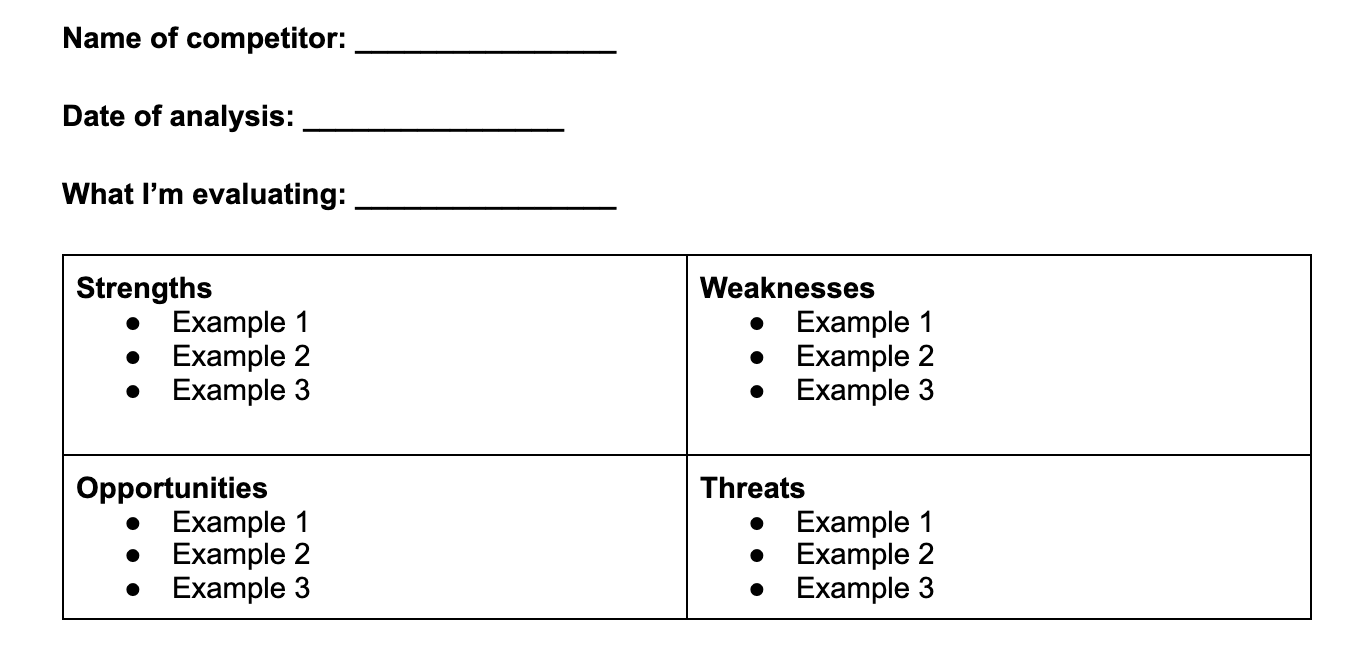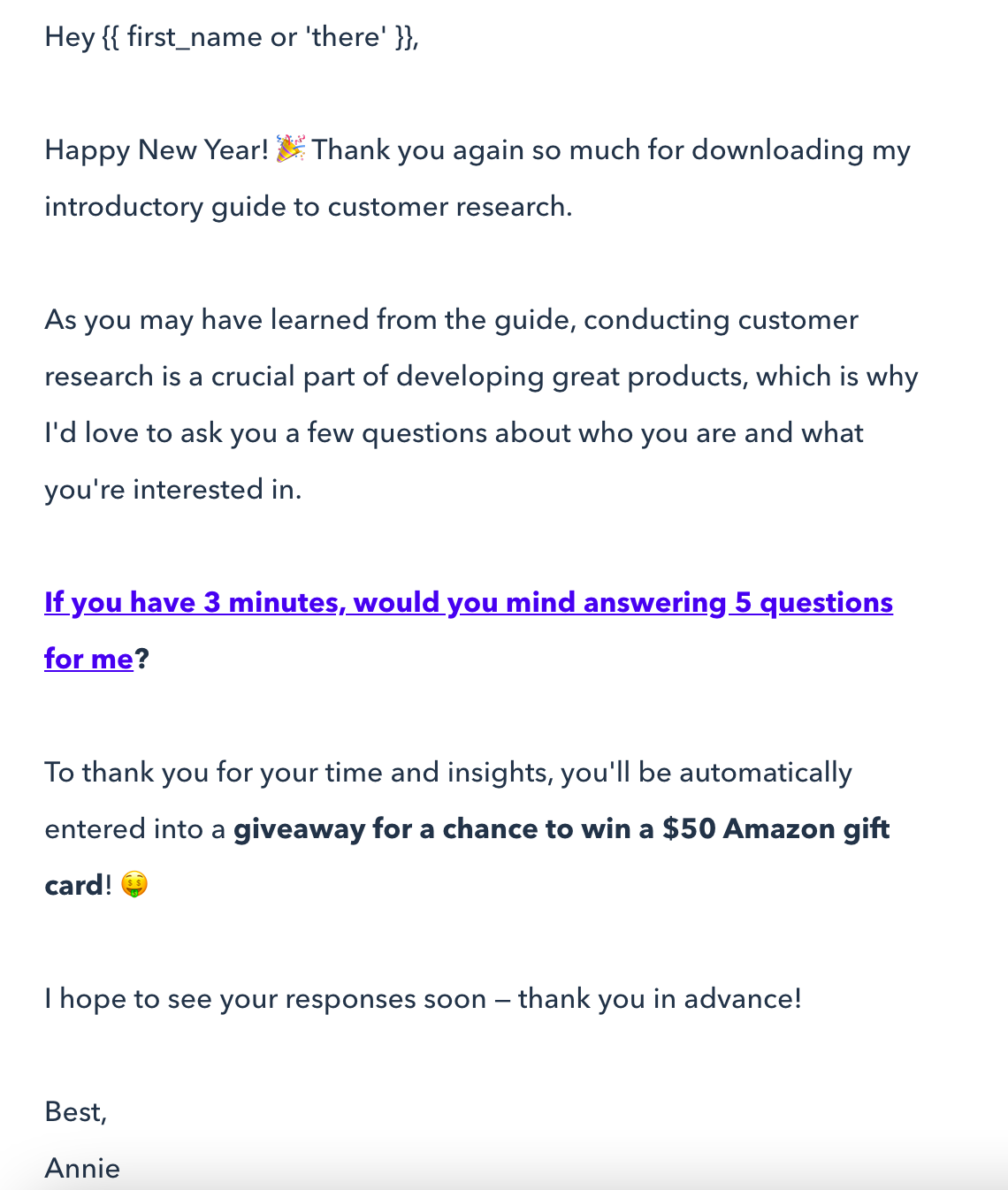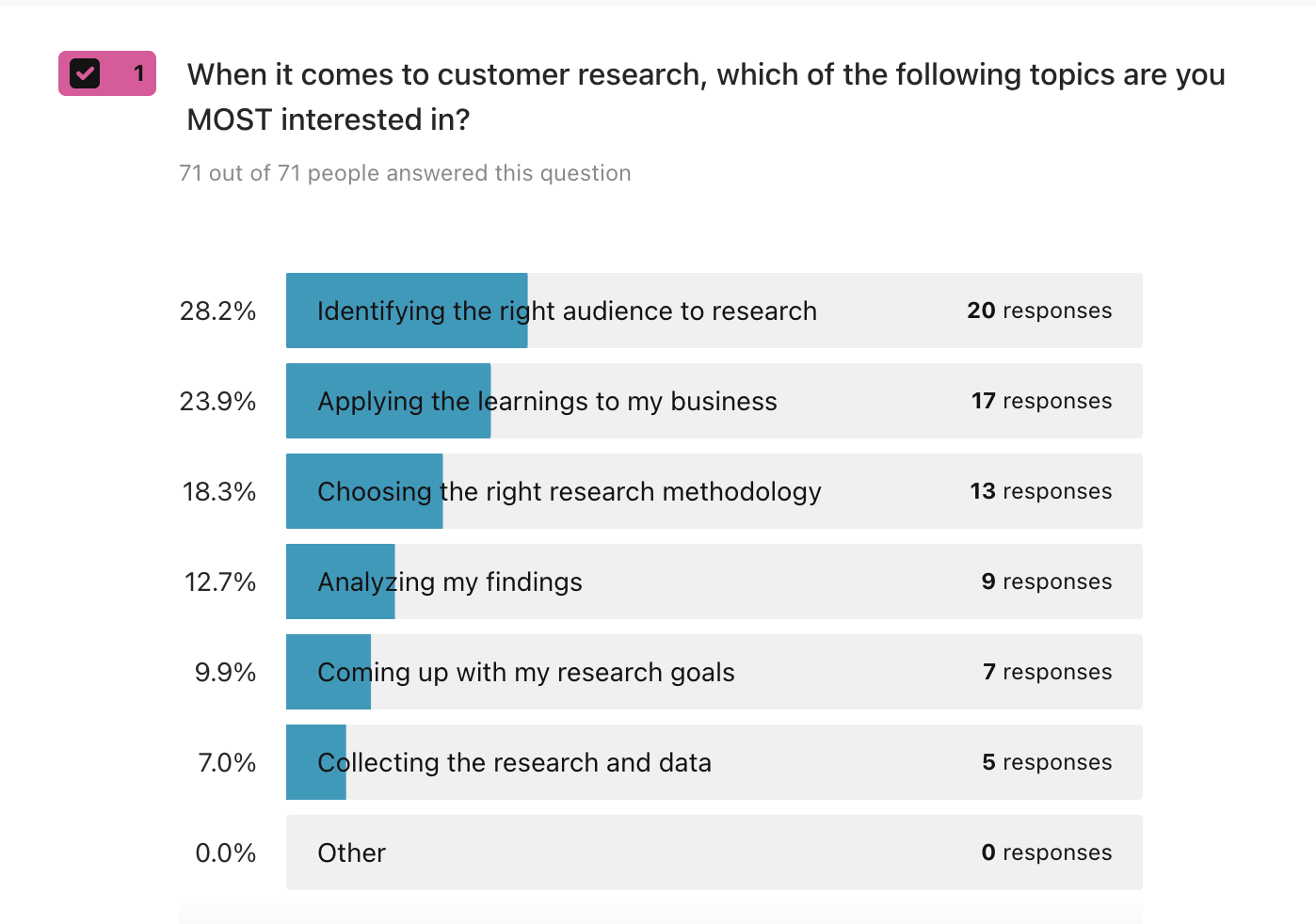Want to see the customer research process in action?
This article is for you!
As you may know, I’m launching my new course, How to Conduct, Analyze & Apply Customer Research on April 20th (and I’m offering a 50% off discount to celebrate the launch!).
In the meantime, I’d love to pull back the curtain and show you how I used customer research to validate, build, and market the course itself, so you can see the customer research process in action.
Keep in mind, this is just one simple example of how you can use customer research to positively impact your product, marketing, and more; the course features many more methodologies, tools, templates, examples, videos, and more, giving you everything you need to use customer research in YOUR business.
If nothing else, I hope this article opens your eyes as to how the simplest forms of customer research can help you build better products and market them more effectively.
If you have questions about this process (or the course), you can always reach out to me directly: annie1maguire@gmail.com
Alright, let’s dive in!
Before starting on the course, I first conducted a SWOT analysis
Before I could create a course on customer research, I needed to know what was out there in terms of competition, so I began my process with a SWOT analysis.
If you’re not familiar, a SWOT Analysis (Strengths, Weaknesses, Opportunities, Threats) is a simple framework you can use when evaluating something: The general market landscape, your competitors, your own website, product, marketing, and more.
Before conducting the analysis, I made a list of things I wanted to learn, including:
- What kind of courses on customer research currently exist?
- Where do they exist? Who is offering them?
- What are the strengths of the courses?
- What are the weaknesses?
- Where do the gaps exist in terms of positioning and content?
- What is the average price point?
- What is the opportunity for me?
Because I didn’t know of any courses on customer research, I did a quick Google search for “customer research courses” to see what came up.
Within my search, I found a lot of free content related to customer research, some customer research tools, and companies offering customer research as a service, but no products like the one I wanted to create.
Nevertheless, I read through all of the content, tools, and services so I could familiarize myself with the competition while also swiping ideas, language, and visuals I could use as inspiration when creating my course and sales page.
Outside of the above, I also found some traditional, “academic-style” courses on customer research (mostly through course platforms or universities), but they seemed more theoretical vs practical.
That being said, I was able to learn something from all of the course options and plotted each of them within my SWOT Analysis chart, which helped me clearly see the entire landscape from a more strategic perspective.
Here’s what my SWOT chart looked like before I began filling it in:

I include a SWOT Analysis template in my course along with 30+ templates, guides, and examples for conducting other types of customer research.
While I learned a lot from the SWOT analysis, I was most focused on the opportunities and gaps in the market, so I jotted down a few things I could do to help my course stand out, including:
✓ Position the course in a way that’s simple and approachable (vs theoretical or abstract)
✓ Focus on creating something that’s actionable and useful for business owners (vs students at a university)
✓ Don’t include any methodologies that are outdated or impractical for today’s modern businesses (just focus on the stuff you actually use in your business/your clients’ businesses)
After completing my SWOT analysis, I then decided to run a few surveys so I could understand my target audience and build a product they wanted actually to buy.
Next, I ran a survey to help me better understand my target audience
In anticipation of my course, I created a lead magnet called An Intro to Customer Research, which allowed me to capture email addresses for leads who were interested in that topic.
By the time I began working on my course, I had a bank of several hundred leads, but I didn’t know anything about them so I decided to send out a survey that would help me uncover:
✓ Background — What do they do for work?
✓ Motivations — What motivated them to sign up?
✓ Interests — What did they want to learn in regard to customer research?
✓ Future purchasing intent — Were they interested in similar content?
To do that, I created a simple Typeform survey and sent out an email to my subscribers asking them to fill out the survey in exchange for a chance to win a $50 Amazon gift card.
I chose $50 because it’s a decent-sized incentive (and would likely get me a lot of results), but it’s also not a huge investment for me, especially if it means learning crucial insights that would make my product and marketing more successful.
This is the email template I used (I include similar email templates in my course):

The link in the email led to a simple Typeform survey featuring these 5 basic questions (looking for more examples of interview or survey questions? I include tons of example questions/templates in my course):
1. Tell me about your business or what you do for work.
Open-ended response
2. Why did you sign up for my free download, An Intro to Customer Research?
Open-ended response
3. What about customer research interests you?
Open-ended response
4. What is the #1 thing you want to learn about customer research?
Open-ended response
5. If I created an online course that taught you how to conduct, analyze, and apply customer research insights to your product, user experience, marketing, copy, etc — is that something you would be interested in?
Open-ended response
Finally, I asked for their email address so I could update them about the winner of the $50 Amazon gift card giveaway.
I gave people a few days to fill out the survey, sent a “last chance!” reminder email, then turned off the survey so I could begin sifting through the results.
Once all of the results were in, I downloaded the responses into a Google sheet and began analyzing the data in search of meaningful insights and recurring themes (this is a process I explain in depth within my course).
After the analysis was complete, I had clarity on a few key things:
- I had a better idea of what my subscribers do for work and which industries they work within (this information could help me choose the right examples for my course)
- I had a better sense of why they signed up for my download (this information gave me insight into their motivations)
- I had some general content ideas for the course (this obviously helped me outline the course from a content perspective)
- I knew that 97% of the respondents were at least interested in learning about my course on customer research (this information helped me validate the product idea before doing any of the work)
With these insights, I had enough information to begin outlining my course (and the sales page) and also had confidence that if I built the course, nearly 100% of my subscribers would be interested in learning more about it.
And while all of this was certainly encouraging, I knew I wasn’t done.
At that point, I only had enough data to validate and outline the idea, but was still missing the deeper insights I needed to build a truly irresistible course.
So, what did I do?
I then ran another survey to help me build the content of the course
Based on the first survey, I had a general idea of the course content, but I wanted to validate my assumptions, get more ideas, and also make sure I wasn’t missing anything, so I decided to run a second survey that was more focused on the course itself.
To do that, I followed the exact same process for the first survey, but this time I used questions that would help me uncover:
✓ Hierarchy (or priority) of content — Which topics are most important to this audience?
✓ Content types — What content formats should I be focusing on?
✓ Price point — How much are people willing to pay for this kind of course?
✓ Motivations — What would motivate someone to buy the course?
✓ Barriers — What might hold someone back from purchasing the course?
To do that, I came up with a mix of open-ended and close-ended (multiple choice) questions, popped them into Typeform, and sent out the request to my audience.
Here are the 5 questions I asked via the 2nd Typeform survey:
1. When it comes to customer research, which of the following topics are you MOST interested in?
- Coming up with my research goals
- Identifying the right audience to research
- Choosing the right research methodology
- Collecting the research and data
- Analyzing my findings
- Applying the learnings to my business
2. If you could design your “dream” Customer Research course, which kind of content would be in it?
- Real-world examples
- Video tutorials
- Audio recordings
- Templates
- Exercises
- 1-on-1 (or group) coaching sessions
- Step-by-step processes
- Written explanations
- Lots of visuals
- A list of tools
- Other
3. If you could buy a course that covered everything you wanted to know about customer research, how much would you expect to pay for that?
Open-ended response (fill in the blank)
4. What would motivate you to invest in customer research this year?
Open-ended response (fill in the blank)
5. What might stop you from investing in customer research this year?
Open-ended response (fill in the blank)
Once all of the results were in, I followed the same process of downloading the responses into a Google sheet and analyzing the data in search of meaningful insights and recurring themes.
Because I asked a mix of closed and open-ended responses, I only had to manually analyze the responses for the three open-ended questions, while Typeform provided me these beautiful charts for the closed-ended questions:


From just 2 of the 5 survey questions, I already had clear direction on which customer research topics to focus on and which types of content would be most appealing to my target audience.
For the open-ended questions, I still had to do a bit of manual analysis, but doing so allowed me to get a clearer sense of what would motivate someone to buy my course and what would potentially stop them, which was helpful information I could use not only for the course itself, but also for my sales page and email sequences.
At that point, I had enough data to build the course and marketing materials, but my research wasn’t done — I needed to actually conduct customer research throughout the course to help me demonstrate how the research methodologies work in real life.
Finally, I conducted my own research to show my customers how the methodologies actually work
Since the beginning, I’ve been focused on creating a course that uses customer research in ways that are practical and useful for today’s modern businesses.
Knowing this, I decided to use my own business as the example for many of the methodologies I teach in my course, making it easy for students to not only understand the methodologies themselves, but how to use them in real life situations.
Here’s a few examples of how I did that:
1. I conducted a competitive analysis for my site
Similar to how I conducted a SWOT analysis at the beginning of my research process, I also conducted a competitive analysis for my own website to show you how the process works, which frameworks to use, how to look for insights that can help you improve whatever you’re evaluating, and more.
2. I conducted usability tests for my site
If you’re not familiar, a usability test is a method of testing the functionality of a website, a digital product, or a physical product by observing users as they interact with it and attempt to complete specific tasks.
In my course, I ran a moderated and unmoderated usability test for my website to show you how to create a proper “test plan,” which tools to use, how to analyze your results, and more.
3. I ran message/design tests
Message/design tests can be incredibly useful when it comes to updating your website, logo, packaging, prototype, or anything that involves copy or design.
In my course, I ran a couple of different message and design tests (including a preference test and a 5-second test) to show you how the process works, how to come up with the right questions, which tools to use, how to analyze your results, and more.
4. I analyzed the data for two surveys
As mentioned above, I ran two surveys before building my course to help me create more effective content and marketing.
In the course itself, I share the results from the surveys and show you how to analyze the results in a clear, organized, and repeatable way, while also teaching you how to look for important insights than can shape your product, marketing, and more.
5. I analyzed visitor recordings and heatmap data from my site
If your’e not familiar, a visitor recording is a video of your visitor’s actions and behaviors while they’re on your website.
In my course, I analyzed the visitor recordings for my own website to show you how the process works, which tools to use, how to identify insights within the recordings, how to combine the insights with other data sets, and more.
These are just a few examples.
In the actual course, I cover over 10 different research methodologies in depth, including the tools, templates, real world examples, video demonstrations, and everything else you need to understand how the process works and how you can use it to improve your own product, marketing, and more.
Using this research-driven approach, I was able to create a course that:
✓ Covers the topics my audience wants to learn about
✓ Features the types of content my audience wants to see
✓ Illustrates the research methodologies in practical, real-world ways
As you can see, conducting, analyzing, and applying customer research to your business, product, marketing, etc is not hard, especially if you have the right processes, tools, templates, and of course, the right teacher (*wink wink*), who can guide you through it.
Interested in using research to improve your product, marketing, and more?
Check out my new course, How to Conduct, Analyze & Apply Customer Research and get 50% off in advance of the official launch on April 20th!
Keep in mind, the special discount won’t be available for long, so be sure sign up now before it disappears next month!
If you have questions about this process (or the course), you can always reach out to me directly: annie1maguire@gmail.com
